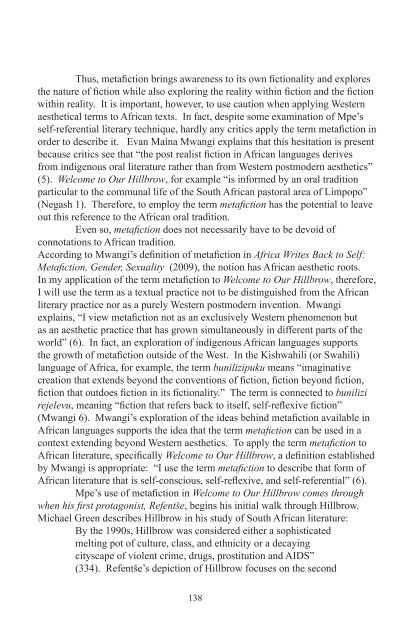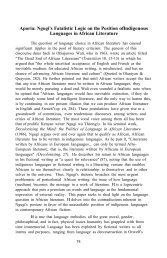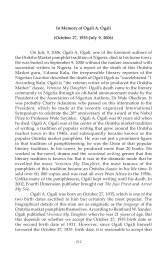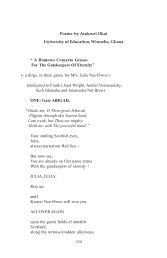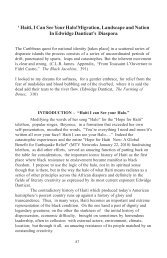Metafiction in Mpe's Welcome to our Hillbrow - African Literature ...
Metafiction in Mpe's Welcome to our Hillbrow - African Literature ...
Metafiction in Mpe's Welcome to our Hillbrow - African Literature ...
You also want an ePaper? Increase the reach of your titles
YUMPU automatically turns print PDFs into web optimized ePapers that Google loves.
Thus, metafiction br<strong>in</strong>gs awareness <strong>to</strong> its own fictionality and explores<br />
the nature of fiction while also explor<strong>in</strong>g the reality with<strong>in</strong> fiction and the fiction<br />
with<strong>in</strong> reality. It is important, however, <strong>to</strong> use caution when apply<strong>in</strong>g Western<br />
aesthetical terms <strong>to</strong> <strong>African</strong> texts. In fact, despite some exam<strong>in</strong>ation of Mpe’s<br />
self-referential literary technique, hardly any critics apply the term metafiction <strong>in</strong><br />
order <strong>to</strong> describe it. Evan Ma<strong>in</strong>a Mwangi expla<strong>in</strong>s that this hesitation is present<br />
because critics see that “the post realist fiction <strong>in</strong> <strong>African</strong> languages derives<br />
from <strong>in</strong>digenous oral literature rather than from Western postmodern aesthetics”<br />
(5). <strong>Welcome</strong> <strong>to</strong> Our <strong>Hillbrow</strong>, for example “is <strong>in</strong>formed by an oral tradition<br />
particular <strong>to</strong> the communal life of the South <strong>African</strong> pas<strong>to</strong>ral area of Limpopo”<br />
(Negash 1). Therefore, <strong>to</strong> employ the term metafiction has the potential <strong>to</strong> leave<br />
out this reference <strong>to</strong> the <strong>African</strong> oral tradition.<br />
Even so, metafiction does not necessarily have <strong>to</strong> be devoid of<br />
connotations <strong>to</strong> <strong>African</strong> tradition.<br />
Accord<strong>in</strong>g <strong>to</strong> Mwangi’s def<strong>in</strong>ition of metafiction <strong>in</strong> Africa Writes Back <strong>to</strong> Self:<br />
<strong>Metafiction</strong>, Gender, Sexuality (2009), the notion has <strong>African</strong> aesthetic roots.<br />
In my application of the term metafiction <strong>to</strong> <strong>Welcome</strong> <strong>to</strong> Our <strong>Hillbrow</strong>, therefore,<br />
I will use the term as a textual practice not <strong>to</strong> be dist<strong>in</strong>guished from the <strong>African</strong><br />
literary practice nor as a purely Western postmodern <strong>in</strong>vention. Mwangi<br />
expla<strong>in</strong>s, “I view metafiction not as an exclusively Western phenomenon but<br />
as an aesthetic practice that has grown simultaneously <strong>in</strong> different parts of the<br />
world” (6). In fact, an exploration of <strong>in</strong>digenous <strong>African</strong> languages supports<br />
the growth of metafiction outside of the West. In the Kishwahili (or Swahili)<br />
language of Africa, for example, the term bunilizipuku means “imag<strong>in</strong>ative<br />
creation that extends beyond the conventions of fiction, fiction beyond fiction,<br />
fiction that outdoes fiction <strong>in</strong> its fictionality.” The term is connected <strong>to</strong> bunilizi<br />
rejelevu, mean<strong>in</strong>g “fiction that refers back <strong>to</strong> itself, self-reflexive fiction”<br />
(Mwangi 6). Mwangi’s exploration of the ideas beh<strong>in</strong>d metafiction available <strong>in</strong><br />
<strong>African</strong> languages supports the idea that the term metafiction can be used <strong>in</strong> a<br />
context extend<strong>in</strong>g beyond Western aesthetics. To apply the term metafiction <strong>to</strong><br />
<strong>African</strong> literature, specifically <strong>Welcome</strong> <strong>to</strong> Our <strong>Hillbrow</strong>, a def<strong>in</strong>ition established<br />
by Mwangi is appropriate: “I use the term metafiction <strong>to</strong> describe that form of<br />
<strong>African</strong> literature that is self-conscious, self-reflexive, and self-referential” (6).<br />
Mpe’s use of metafiction <strong>in</strong> <strong>Welcome</strong> <strong>to</strong> Our <strong>Hillbrow</strong> comes through<br />
when his first protagonist, Refentše, beg<strong>in</strong>s his <strong>in</strong>itial walk through <strong>Hillbrow</strong>.<br />
Michael Green describes <strong>Hillbrow</strong> <strong>in</strong> his study of South <strong>African</strong> literature:<br />
By the 1990s, <strong>Hillbrow</strong> was considered either a sophisticated<br />
melt<strong>in</strong>g pot of culture, class, and ethnicity or a decay<strong>in</strong>g<br />
cityscape of violent crime, drugs, prostitution and AIDS”<br />
(334). Refentše’s depiction of <strong>Hillbrow</strong> focuses on the second<br />
138


